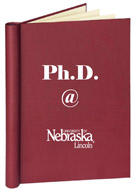Graduate Studies, UNL

Dissertations and Doctoral Documents, University of Nebraska-Lincoln, 2023–
First Advisor
Michael A. Herman
Degree Name
Doctor of Philosophy (Ph.D.)
Department
Biological Sciences (Genetics, Cellular, and Molecular Biology)
Date of this Version
7-2024
Document Type
Dissertation
Citation
A dissertation presented to the faculty of the Graduate College of the University of Nebraska in partial fulfillment of requirements for the degree of Doctor of Philosophy
Major: Biological Sciences (Genetics, Cellular, and Molecular Biology)
Under the supervision of Professor Michael A. Herman
Lincoln, Nebraska, July 2024
Abstract
Microbiomes are a fundamental part of eukaryotic organisms and play a role in both host health and fitness. Although microbiomes are often associated with health and positive effects on the host, certain microbiome compositions are also associated with disease. We used Caenorhabditis elegans and its experimental microbiome, CeMbio to explore the interactions that individual microbiome members have with other microbes, with the host, and how the entire microbiome community interacts with the host. We found that individual CeMbio members have varying effects on host health and fitness compared to the whole community. This suggested that there is synergy occurring in the microbial community that influences the host response to the microbiome. A member of CeMbio, Stenotrophomonas, has been previously shown to be detrimental to C. elegans health in monoculture. We characterized the role of Stenotrophomonas in the microbial community to address the question of the role of detrimental microbiome members in host health, fitness, and microbiome composition. We used several Stenotrophomonas strains and determined their individual roles by substituting them into the experimental microbiome. We found that most substituted microbiomes result in comparable health and fitness, except those containing pathogenic Stenotrophomonas maltophilia strains. Additionally, we determined that the microbiome assembly is not influenced by the specific strain of Stenotrophomonas, but was influenced by host age and genotype. To better model the natural interactions between C. elegans and Stenotrophomonas we measured survivorship of nematodes after they previously experienced Stenotrophomonas during development, the prior generation, or the combination of the two. We found a slight protective effect against Stenotrophomonas when the prior generation is exposed to the pathogen. Overall, we have begun to uncover the role of detrimental microbiome members, specifically that of Stenotrophomonas, and understand the natural context of the C. elegans-Stenotrophomonas relationship. Moving forward there is still much work to be done to fully understand the nuances of these interactions. Investigating metabolic capabilities, gene expression, and specific microbe-microbe interactions will continue expanding our knowledge pertaining to detrimental microbiome members.
Advisor: Michael A. Herman
Recommended Citation
Foltz, Ashley Elizabeth, "Manipulations of the Caenorhabditis elegans Microbiome Reveal Influences of Detrimental Members on Host Life History Traits" (2024). Dissertations and Doctoral Documents, University of Nebraska-Lincoln, 2023–. 150.
https://digitalcommons.unl.edu/dissunl/150


Comments
Copyright 2024, Ashley Elizabeth Foltz. Used by permission